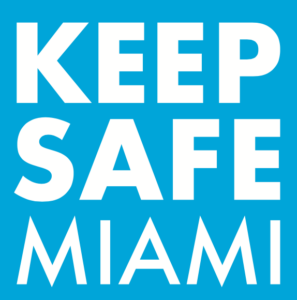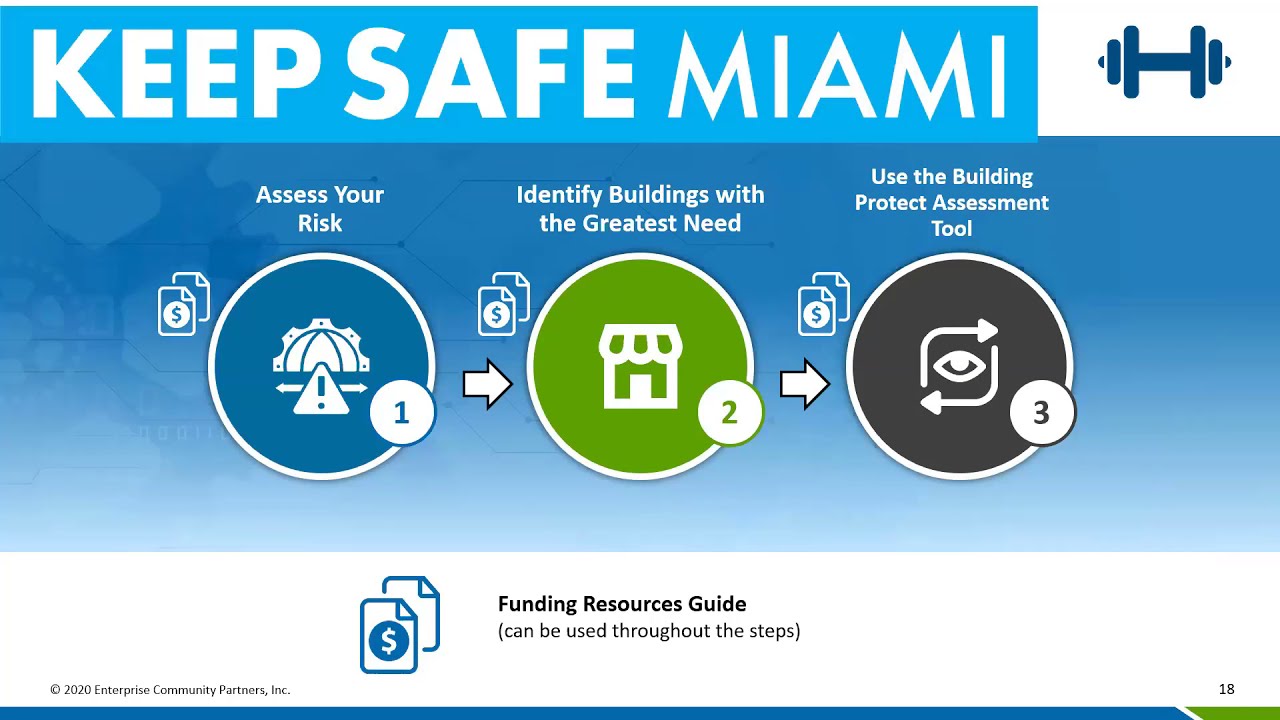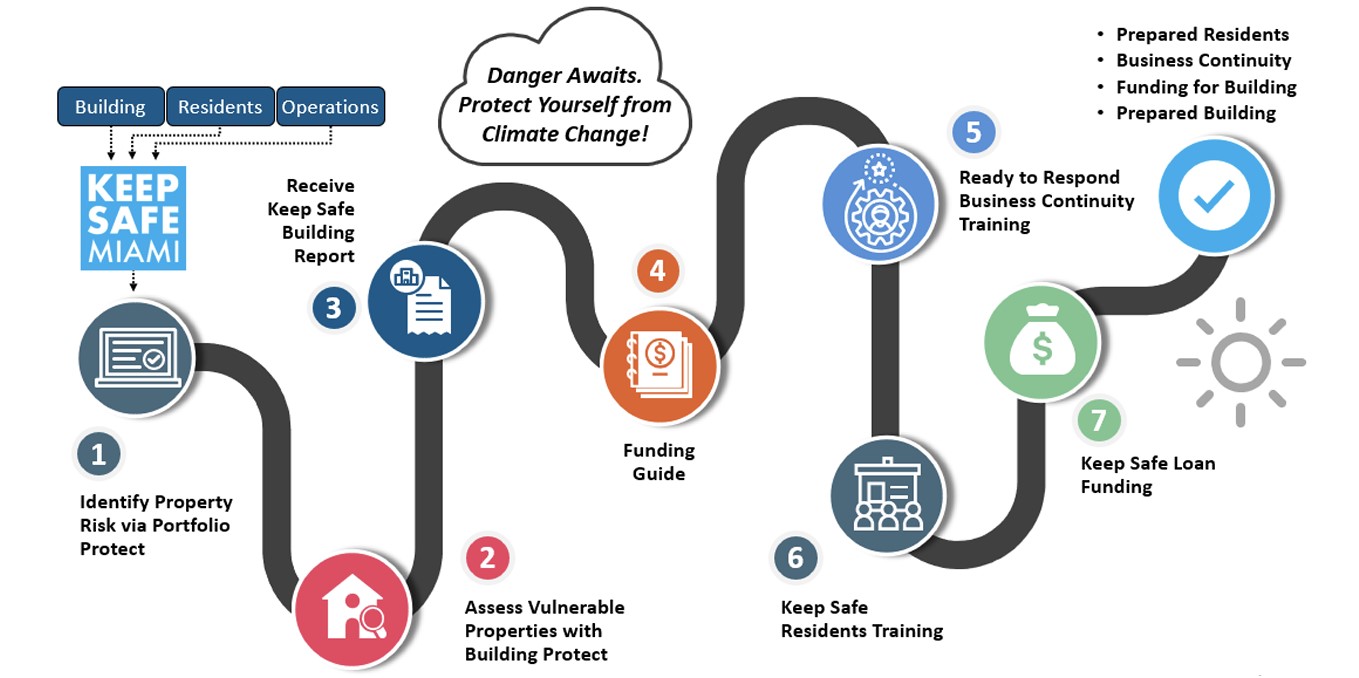Strong partnerships with community organizations, local governments, key to Keep Safe Miami resilience program

Source: Twitter, @CityofMiami
Resilience is a journey, and the sustainability staff at the City of Miami are determined to reach their destination. The ever-progressing impacts of climate change across south Florida don’t make the road easy, particularly for those living in the area’s affordable housing communities. But working alongside strong community partners like Enterprise Community Partners, and others, has helped pave the way for strengthening resilience within the City of Miami’s affordable housing communities through their Keep Safe Miami program.
The ultimate goal: protecting people
South Florida is no stranger to the effects of climate change and extreme weather. Folks in this part of the state are accustomed to seeing their geographic location in the path of tropical storms often during hurricane season. And climate change is dealing more blows, even when the weather forecast is clear: sunny day flooding due to sea level rise.
These types of events are occurring with more frequency each year, oftentimes hitting already-vulnerable communities hardest. Hurricanes are disrupting life on a larger scale, leaving damaged property and injured people in their wake. And sunny day flooding is taking a toll, as well.

Jonathan Klopp; Resilience Programs Manager; City of Miami, FL
“We’re seeing that sunny day flooding is proving to be a disruptor, too,” said Jon Klopp, Resilience Programs Manager with City of Miami. “These types of events are keeping people in impacted communities from getting to work, keeping doctor’s appointments, and going to the grocery store. Basic daily life is being impacted. From hurricanes to other localized flood events, a complex layer of impacts are presented when people are pushed out of their homes. The mission we sought out to accomplish was to prepare people for these effects and mitigate this factor of an already-challenging housing crisis.”
Fortunately, one community partner in particular, Enterprise Community Partners, had a tool that could help: a technical support system created to equip affordable housing owners with tools and resources to assess and address threats from climate change and natural disasters. That tool was identified as a good fit for the challenges the City of Miami was trying to address.
City of Miami provided a portion of the initial funding to develop the tool, and Enterprise Community Partners found additional funding to make the tool available across Miami-Dade at the time of the program launch.

Sara Haas; Senior Director, Southeast Market and National Preservation Program; Enterprise Community Partners
“Enterprise developed the Keep Safe tool for communities to help them identify and map a property’s vulnerabilities, tying the specific findings to tailored strategies communities can act on,” said Sara Haas, Senior Director for the Southeast region with Enterprise Community Partners. “It’s those actionable recommendations that are the key to the program’s success. It empowers property owners with the information they need to make changes or improvements that will have the greatest impact in strengthening their building structure’s resilience and protecting the health and safety of the people who live there.”
Making the tool work for Miami-Dade
City of Miami worked alongside Enterprise Community Partners for nearly a year, developing a tool that took the region’s unique characteristics and needs into account. It’s been an iterative process, collaborating with property owners, residents, and other community organizations and stakeholders all along the way. Once the needs were identified, the goal was to match the needs with available funding resources to cover the costs of implementing the recommended action items.
“We know that people in affordable housing tend to lack the necessary resources to tackle issues like this,” said Klopp. “And we wanted to be careful that we were meaningfully addressing the most important issues. You can’t address a problem unless you’re able to measure it, and the Keep Safe Miami tool provided the mechanism we needed to truly scope the issues and needs - and funding opportunities - to provide residents with better access to disaster preparedness training and preparation.”

Source: Enterprise Community Partners, Inc.
Starting with a set of best practices and comparable programs as a springboard, Enterprise Community Partners helped guide the City of Miami through the development of their tailored program model. Similar programs had recently been launched in New York and Washington, D.C., which provided a foundation of information to get started.
The team leveraged a self-assessment tool Enterprise built in other regions that building managers in City of Miami and, more broadly, Miami-Dade County could use. The tool was designed to identify opportunities that property owners could take that would better protect them in the next hurricane, flood, or other natural disaster.
As the tool was developed, an advisory board was convened to help inform their work along the way.
“Feedback from the advisory board was critical,” said Klopp. “Some of the most important input you can get for a program that’s intended to help a certain group of people is to get those people engaged in the process. Getting practical insights from the very people who would ultimately be using this tool and benefit from it was foundational to our success. After all, the tool is only effective if people actually use it.”
Ready, set…
In February 2021, the tool was ready and the team executed its launch. COVID-19 lockdowns were still in place, making it difficult to conduct the outreach they’d planned to multi-family property owners and residents of affordable housing.
The team persisted, leveraging online platforms to conduct some of the outreach activities, and get the input needed to further hone the tool as their target audiences began trying it out. The assessment tool has been tweaked as users provide feedback, but beyond the COVID setbacks, one of the most challenging issues has been securing the funding to execute on the implementation of identified preparedness opportunities.
“As we got some of our first few building assessments in, pairing those with funding resources, the realities of how difficult it would be for building owners to take on debt for larger projects - even when the loans would be forgiven in a matter of years - proved to be a barrier,” said Klopp. “The folks we’re working with aren’t always accustomed to going through these kinds of processes, so we found that unless the owners are using this as simply a part of a larger, planned rehabilitation effort at their property, it was difficult for them to take on the debt.”
To address this challenge, City of Miami and its partners exercised flexibility and further honed its audience, revising its target to properties where the available funding was a better match and more likely to be able to cover the costs of a resilience project from start to finish. They also developed a funding guide to help walk property owners and residents through the application and approval process, including counseling on documentation requirements that might be required as the funds were used.

Source: Enterprise Community Partners, Inc.
Continuing the commitment
Because the City of Miami prioritizes its climate adaptation strategy, they remain committed to the goals of the Keep Safe Miami project and even have explicit goals for increasing the resilience of affordable housing communities - goals that align with the local government’s other climate resilience objectives.
The Keep Safe tool is on its third iteration now, and the work continues. They’ve evolved the tool to now offer a self service track and a learning collaboration track so that folks who need more support and guidance have an opportunity to work with peers and consultants on their assessment and funding needs. And, with the latest iteration of the program relaunched in May, the program has expanded access to Broward and Palm Beach counties, as well as to Tampa and Orlando.
“It’s exciting,” said Klopp. “We’re starting to see more adoption, more interest from owners and operators. We’re hearing from property owners that they’re learning more about their buildings, finding things they can do that will have an impact on health and the sustainability of their buildings. Seeing that we’re making a difference is a great motivator to keep at it.”
“With the Keep Safe tool, we’ve found that property owners want to be an integral part of the process at every step along the way,” said Haas. “People really embrace the opportunity to engage with others on this topic, learning from what others are finding and how they’re addressing their needs. The partnerships with local governments on the Keep Safe tool are so valuable in helping us make the Miami-Dade project successful, and in refining the tools to make programs like this successful all across the country.”
In the next five years, City of Miami would like to see the annual number of users jump from a few dozen or so up to 100 or more, tracking the implementation rates to follow what communities are putting into place and how the measures are helping strengthen resilience.
“It’s been a really smooth process, in spite of the challenges Covid overlaid during the launch,” said Klopp. “We hope that what we’ve learned and the progress we’ve made in the City of Miami’s program will help pave the way for local governments across the country to implement a Keep Safe program in their own communities, helping improve resilience for folks who otherwise wouldn’t have resources to take action on their own.”